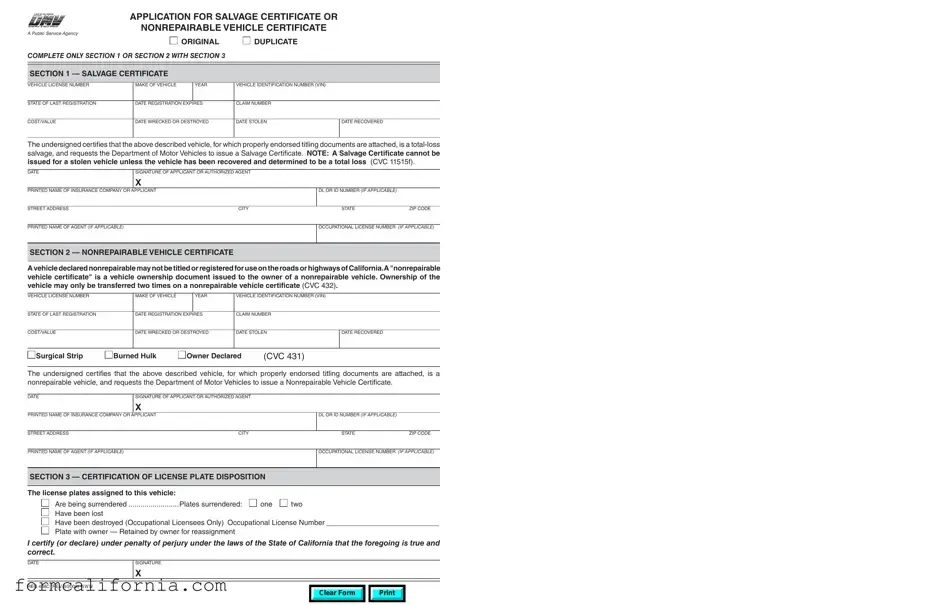The Application for Duplicate Title form shares similarities with the CA DMV 488C form in the primary objective of altering the state's vehicle records. Just as the 488C form is used to request a Salvage or Nonrepairable Vehicle Certificate, the duplicate title application seeks to replace a lost or destroyed vehicle title, ensuring the vehicle's ownership status is updated in official records. Both forms serve as crucial tools in the administration of vehicle documentation, necessitating accurate and truthful information to process changes in ownership status or vehicle classification.
A Notice of Transfer and Release of Liability form, another document processed by the DMV, parallels the CA DMV 488C form in its role in updating vehicle records. While the 488C form is dedicated to recognizing a vehicle as salvage or nonrepairable, the Notice of Transfer and Release of Liability form is essential for notifying the DMV when a vehicle changes ownership. This ensures that the seller is released from liability for anything that happens with the vehicle after the sale, similar to how the 488 in its capacity facilitates a change in the vehicle’s legal status.
The Vehicle Registration Application also bears resemblance to the 488C form by interacting with vehicle classification within DMV records. In contrast to the 488C form's objective to certify a vehicle as salvage or nonrepairable, the registration application's purpose is to initiate or renew a vehicle’s active status for legal operation on public roads. Both applications are necessary for accurately reflecting the current state and standing of a vehicle in accordance with California law.
The Statement of Facts form complements the CA DMV 488C form due to its use in providing supplemental information to the DMV for various transactions. This form can be used to clarify circumstances or provide additional details about a vehicle’s condition similar to how the 488C form declares a vehicle as salvage or nonrepairable. The Statement of Facts form serves as a versatile instrument for individuals to communicate additional nuances or necessary clarifications about their vehicle or its status to the DMV.
The Application for Replacement or Nonrepairable Vehicle Title is akin to the 488C in its focus on reclassifying or updating a vehicle's title and condition status. Whereas the 488C form is specifically used for salvage or nonrepairable vehicles, this application facilitates the issuance of a new title when the original has been lost, stolen, mutilated, or the vehicle is deemed nonrepairable. Both forms are integral in the DMV’s process of maintaining current and accurate vehicle records, allowing for proper titling and classification.
Change of Address form, while administratively oriented, aligns with the CA DMV 488C form in its capacity to update vital information within DMV records. This form's primary function is to ensure that vehicle and driver records are current regarding the owner's mailing address, similar to how the 488C form updates the vehicle's status. Timely submission of a Change of Address form, like that of the 488C, is crucial for receiving renewal notices, legal correspondence, and maintaining accurate DMV records.
The Odometer Disclosure Statement, required during many vehicle transactions, shares its goal of transparency with the CA DMV 488C form. This document records the mileage of a vehicle at the time of sale, providing a clear history of its usage, akin to how the 488C form certifies a vehicle's condition as salvage or nonrepairable. Both forms contribute to a transparent and honest vehicle market, ensuring buyers and sellers are well-informed about the vehicles in which they are dealing.


